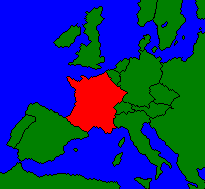  Seventeenth and Eighteenth Century France
|
| Origin | Later Developments | Documentation | Review Quiz |
OriginThe history of the organ in France doesn't really begin in the seventeenth century, of course. As you might imagine, the organ was a part of musical life in France long before then. Records indicate the presence of instruments in major religious institutions from the thirteenth century on, and some surviving sixteenth-century instructions for registration originated in France. 124 All during this time, though, there was no distinctively French organ to be found. Instruments from the northern part of the country were heavily influenced by developments in the lowlands, and those in the south had strong similarities to organs in Italy. It was not until the seventeenth century that a truly French style of organ building developed, at first in the areas centered around Paris and Normandy. It was there that the first organs were built incorporating the features that have since been recognized as constituting the French Classical organ. This set of characteristics dominated organ-building in France for over a century, from the first half of the seventeenth century through the waning years of the eighteenth. The qualities of endurance and longevity have contributed to the modern tendency to call these instruments "classic" or "classical." In addition, composers of the time wrote music that is intimately connected in style and genre with the organs themselves. The period of French Classicism is thus a "classic" example of cooperation and inter-relationship between the organ builders, their instruments, and the music composed for those instruments. In general, the typical French organ of the period owes its primary characteristics to its predecessors of the lowlands:
|
| Origin | Later Developments | Documentation | Review Quiz |
Later DevelopmentsThe eighteenth century saw little change in the overall approach of a French organ-builder to his trade. The general pattern of Grand orgue, Positif, Récit, Echo and Pédale that developed a century before was by 1700 found in instruments throughout the realm. In detail, however, the organs of the eighteenth century, some of which remain in an unaltered or restored condition, show some differences when compared to their predecessors.
|
| Origin | Later Developments | Documentation | Review Quiz |
DocumentationWe have quite a lot of information about organs in France in the seventeenth and eighteenth centuries. Even when instruments themselves have been altered, the stoplists have often been retained, and sometimes, as in the case of the Thierry instrument played by generations of Couperins in paris, we have several first-hand reports describing the organ as it once was. In addition, composers' registration instructions provide us with an excellent picture of the way in which these instruments were used, giving us much more detail than we have in other places in the seventeenth and eighteenth centuries. So far as written sources are concerned, there are two major publications with which you should be familiar, one from very early in the period, the other from the very end.
As noted above, composers' registration instructions appear in several different modern editions, and finding English translations is not difficult. You are encouraged to look up instructions by Nicolas LeBègue and Jacques Boyvin in particular, because they give not only suggestions for registrations, but also instructions for choosing an appropriate tempo and realizing ornaments. 127 Additionally, some builders left instructions for registration. The eighteenth-century organ in Gimont is a case in point. It was built in 1772 by Godefroy Schmit, a German builder working near Toulouse, in south France. There are suggested registrations written by the builder and posted on the rear of the case. A description of this organ is included as a separate page of this tutorial. As with other organs of the seventeenth century and later, the instruments themselves are the most important surviving documentation of building practices of the period. Unfortunately, virtually all French organs of the seventeenth-century have been modified, so that there is no one place where we can visit an instrument of the period in its original state. Several instruments of the eighteenth century do survive, however, and they provide us with solid examples of both the construction and sounds of these organs. Several instruments are described on separate pages of this tutorial, most of which date from late in the period:
|
| Origin | Later Developments | Documentation | Review Quiz |
© 1999, 2000 James H. Cook